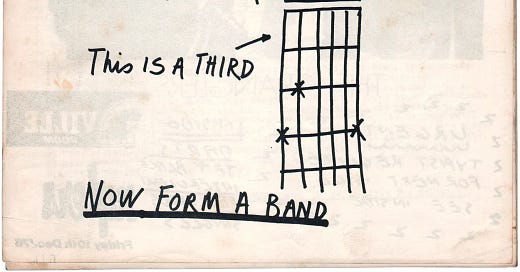"Any tone can succeed any other tone, any tone can sound simultaneously with any other tone or tones, and any group of tones can be followed by any other group of tones, just as any degree of tension or nuance can occur in any medium under any kind of stress or duration. Successful projection will depend upon the contextual and formal conditions that prevail, and upon the skill and the soul of the composer."
— Vincent Persichetti, Twentieth-Century Harmony
There are norms and there is the breaking of those norms. There is the creation of new norms. In some ways, Persichetti is saying anything goes; but he also warns not just anything is automatically successful in expressing what needs to be expressed.
Up until this point, we've looked at the norms in songs with only two chords. The usual suspects, as it were. But truly, we can pair any two chords together and it becomes its own norm, for at least that song anyway. Why did tonic-dominant, tonic-subdominant, and tonic-subtonic pairs become the norm? Part of it, as explained previously, had a lot to do with combining melodies, particularly singable ones. In a basic, very generalized sense, more potential pitches you add to your possible gamut, or the more you stray from existing norms, the more difficult it is to sing.
Now that much of songwriting in the English-speaking world in the past 100 years or so (but particularly after WWII) happens with a guitar in hand, many of the harmonic norms have changed toward what is easy on guitar. The E, A, and D chords are readily available, as are G, C, and D. In classical music, going from A major to C major is… not rare, but special, because it doesn't fit into the predominant paradigms of pitch collections and singability. However, it's an easy thing to play on guitar, because they're both open chords (= some strings are not fretted by the fingers on the fingerboard). This focus on playability is how you get…
…which from a traditional theory standpoint is complicated: The A chord and the E chord form a tonic-dominant pair in A major, the A chord and the G chord form a tonic-subtonic pair in A mixolydian, but the E chord and the G chord are not from the same scale, so one of them has to be considered “borrowed.” Of course, the whole point is: Who give's a rat's ass? It sounds good! It's easy to play! It doesn't sound like classical music or European folk music! This is now one of the prevailing norms.
I'm going to start incorporating less common chord pairs into the mix, starting with the next three songs, some of which can be nicely explained by existing Western theory and some of which may strain the system. But we love to strain the system! Keep an ear out for it.




